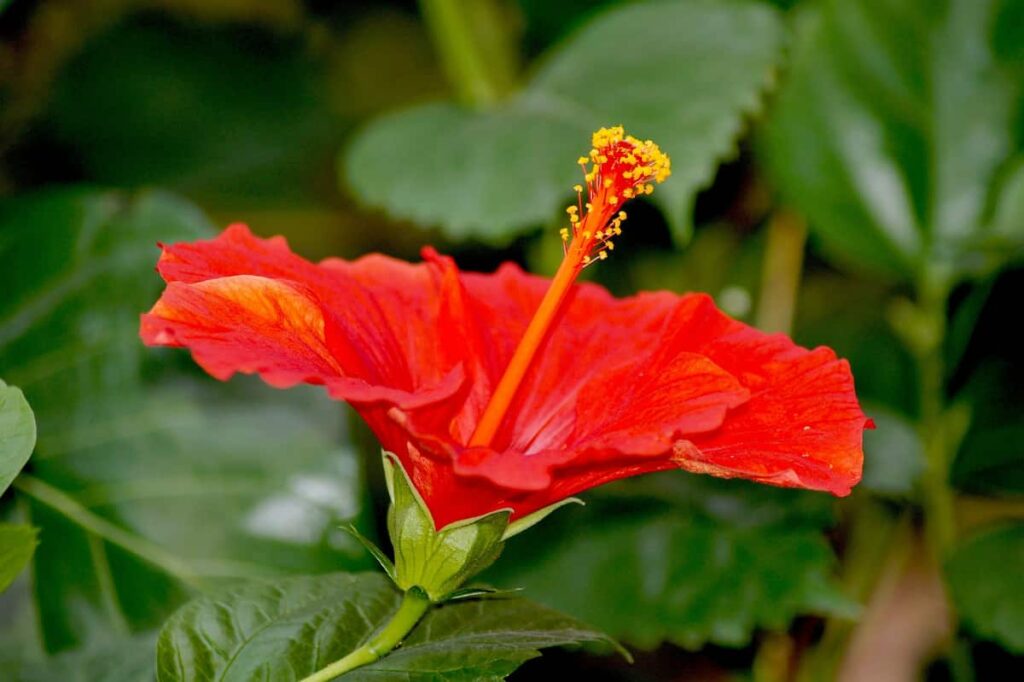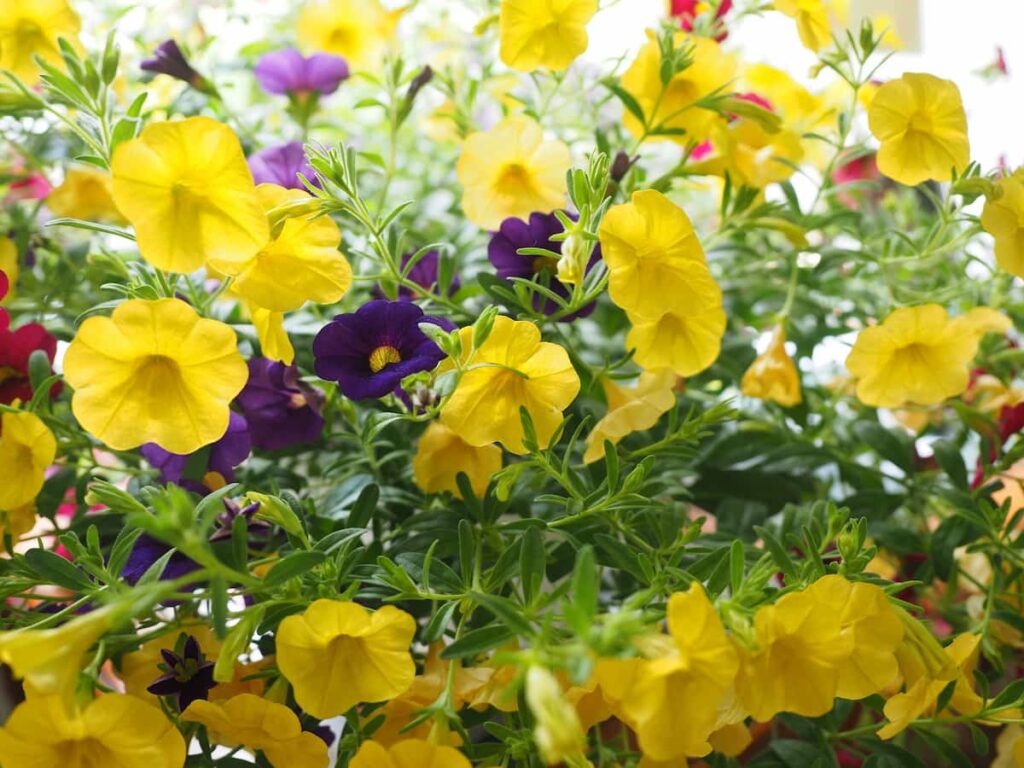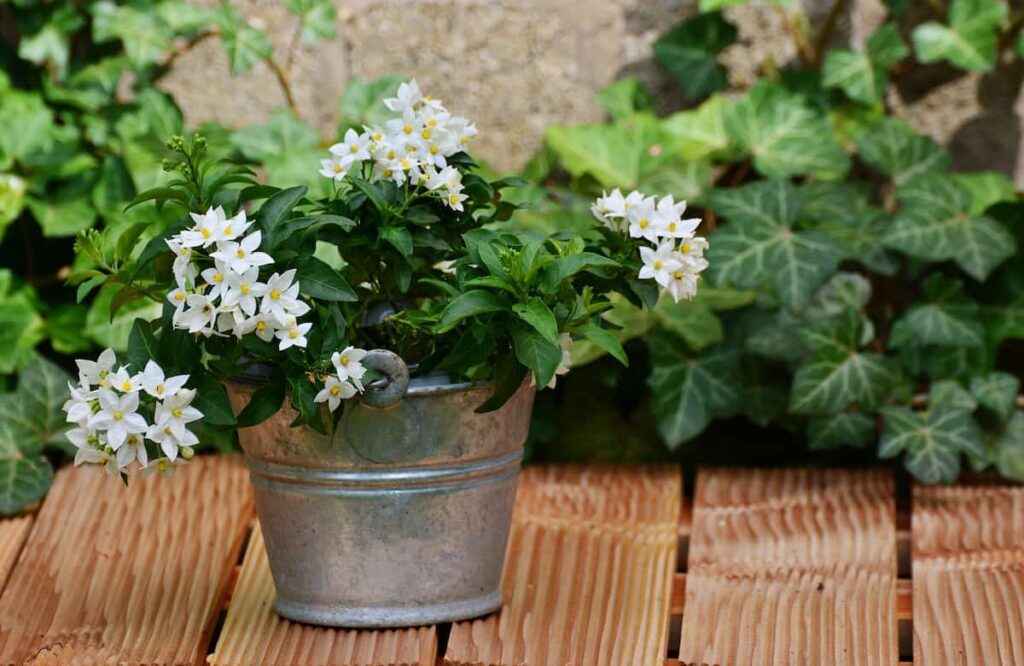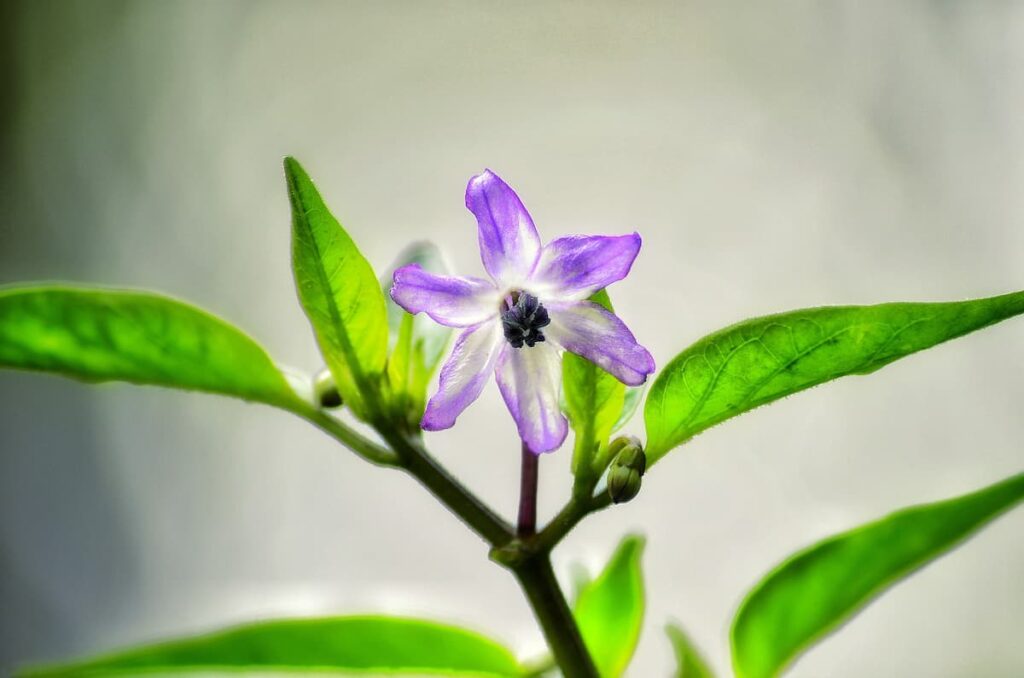Color, fragrance, and beauty can be instantly introduced into our lives with container gardening with flowers. Any landscape can benefit from flowers on a deck, patio, porch, or balcony. Gardening in containers adds versatility to gardens of all sizes. The right plants can add instant color, provide a focal point, link the house’s architecture to the garden, hang them from your porch, or mount them on a windowsill.
You can place them on the ground, on a pedestal, or mount them on a windowsill. A pair of matching containers flank each side of the front walk as a welcome decoration. Alternatively, container gardening on a deck or patio can add color and ambiance. You can use one large container for outdoor decoration, but you can also arrange groups of pots, both small and large, along stairways, terraces, or anywhere in the garden.
A collection of favorite plants can be displayed in clusters of pots. Plants that summer outdoors in the shade also look great in container gardens. Hanging baskets and window boxes provide even more options for adding instant color. Choosing which flower to grow can be the most challenging part of container gardening since there are many wonderful choices. The following are some best annual plants that adapt well to pots and planters.
25 flowers for container gardening
Hibiscus
Combined with its exotic blooms and lush leaves, the hibiscus makes a stunning potted plant. Various colors of hibiscus exist, including red, orange, yellow, pink, and bicolor. In tropical climates, hibiscus acts as a perennial plant, but in colder climates, they behave like annuals and die off.
Hibiscus roots need to be well-drained, so use a pot with drainage holes and a tray or saucer underneath. Fill the planter with soil and use a coffee filter to prevent soil from escaping through drainage holes. Ensure that excess water is drained after each watering to avoid root rot.

Calla Lilies
Calla lilies, also known as trumpet lilies or Lilies of the Nile, have waxy-white flowers with graceful twists and curls. The flowers of a calla lily can be pink, orange, red, or dark green. Heart-shaped foliage can also be varied with white spots. Plant containers can be used to grow calla lilies, which can grow up to two feet tall. For calla lilies, pots should be a minimum of 10 to 12 inches in diameter and well-draining. Calla lilies need moist soil, but improper drainage can lead to rot and fungal infections.
Dianthus Plant
Many of these flowers are annuals, but some are biennials as well. These plants make excellent container plants because of their flowers. You can use them to brighten up your boring balcony. The Dianthus Plant needs full sunlight and fertilizer once a month. To keep the soil moist, you need to water them regularly. The soil should not be overwatered or allowed to dry out.
Mandevilla
Mandevilla, also known as rock trumpet, is a genus of flowering vines in tropical and subtropical climates. Trumpet-shaped flowers with five petals are usually showy and fragrant, usually in shades of pink, red, and white, sometimes with yellow throats. You can grow Mandevilla vines in a hanging basket or container on the ground.
For best results, plant one plant per 12 – 14-inch container. These hardy vining plants bloom profusely in the summer heat if planted in a rich, well-draining potting medium. If you want more flowers, fertilize them with phosphorous-rich fertilizer. It is important to water the plant only when the soil has dried completely.
Million Bells
A million bells come in many stunning colors and look beautiful in almost any container garden. A million bells are available in white, yellow, peach, red, and shades of pink and purple with single, double, or ruffled blooms. Plant Million Bells in containers or the ground after all frost danger has passed in the spring. To make a full container, plant 2 to 3 plants in a 12-inch pot. When fed regularly, the blossoms will attract hummingbirds and butterflies throughout the summer. Maintain an even moisture level by watering it well.
In case you missed it: Cool-season Plants for Pollinators: Vegetables, Flowers, Fruits, Shrubs, and Herbs

Butterfly Pea / Shankhpushpi
A striking dark blue color adorns the flowers of the Butterfly Pea. Training or supporting the vine clusters that bear blooms is necessary. Water the plant regularly in the first growing season, but don’t overwater it. The spurred butterfly pea vine is drought-tolerant and requires supplemental water only during hot, dry weather. It can be used in any container.
Impatiens
Container plants like impatiens make excellent annual plants. Busy Lizzie is another name for these plants. A shaded and moist environment is ideal for plants. Planting them after winter is, however, the best practice. When grown in containers, these plants must be planted in moist, humus-rich, and well-drained soil. The container plants need to be watered regularly. Make sure the plants have better drainage.
Bleeding heart vine
The bleeding heart graces a shade garden in late winter with its soft drift of lacy foliage, followed by graceful heart-shaped flowers in late spring. The blooms will appear in late spring to early summer, lasting several weeks. The plant typically grows up to 2 to 3 feet and 3 feet wide. If you plan to grow this in a hanging basket, choose a smaller cultivar unless you have a very large pot.
Jasmine
It is possible to choose from so many different variants of the mogra plant family. The flowers of all jasmine are star-shaped and have a sweet and distinctive fragrance. In addition to growing jasmines in pots, you can also grow them in the ground. All of them require relatively simple care. Full sun and moist conditions are ideal for jasmine.
In case you missed it: 16 Fragrant Spring-flowering Shrubs: How to Grow, Planting, and Care

Once the flowers have withered away, deadhead them and prune happily to promote rapid growth. In summer, fertilize with a high potash fertilizer every two weeks and mulch with well-rotted manure or leaf mold in autumn. Once the flowers have bloomed, cut them back. If the topsoil is dry, water it, don’t let it completely dry out.
Verbena
Verbena is an excellent container garden plant because it flowers all summer and fall. Verbenas also attract butterflies as a bonus. These profuse bloomers come in many colors and are extremely forgiving. Varieties of Verbena include white, yellow, orange, peach, red, pink, purple, violet, lavender, and bi-colors. Drought-tolerant, they only require an average amount of water. Verbenas are popular in outdoor pots because their blossoms are solid or bicolor from mid-summer to fall.
Bright Eyes begonia
The colorful flowers and foliage of begonias make them a popular perennial plant. You can grow most begonias outdoors in pots or hanging baskets in filtered light and moist but well-drained soil. Plants that are not hardy can be grown as annuals or indoor plants. The foliage is very attractive with its large, smooth, cleft leaves. Flowers bloom from winter to spring and are fragrant and pink. This flowering plant adds color to the garden all year round in tropical climates. The plant prefers filtered light in the summer, but it can also tolerate some sun in the winter. Ideally, the soil should be moist.
Calibrachoa
Usually grown as an annual, this plant is a tender perennial. From spring to fall, it blooms in shades of blue, violet, white, yellow, red, orange, peach, bronze, or pink. Full sun to partial shade is required for this plant. Hanging baskets are ideal for Calibrachoa because of its trailing habit. It’s also possible to cover a small container with a single plant. In the summer, the billowy flowers slow down, but once the weather cools, they return. The plants will bloom until frost, or the days will get shorter if given constant moisture. The plant will grow between 6 and 10 inches in height and 18 to 24 inches wide.
Browallia
The blossoms of this flowering plant have a velvety texture, blue color, and contrasting center. In a mixed container garden, browallia goes well with almost anything and can reach up to 12-14 inches in height, making it ideal for use in the middle. Browallias aren’t fussy, but they need protection from too much heat. It is essential to have good drainage. Throughout the summer, this profuse bloomer will thrive with regular feedings. Keep the plant well-watered and well-drained.
In case you missed it: How to Create a Beautiful Flower Garden in the Balcony

Ixora Plant
The Ixora Plant is a beautiful plant seldom seen as a houseplant. However, you can grow Ixora as a houseplant if you have the right container. Ixora plants prefer moist, sandy loam to loamy, slightly acidic soil. Preparing a potting mix with 60% loamy soil, 20% cocopeat, and 10% sand is ideal.
You can also use any good drain peat moss potting mix that contains peat moss. For propagation of Ixora, you can use this potting mix. Subtropical regions are where they are found, and they require a specific environment to thrive. Ixora’s ideal amount of sunlight is 4 to 6 hours per day. Water is needed in the summer, but less in the winter.
Hydrangea
A shrub hydrangea is the best flower plant type to grow in a container. Even though these exotic, big, clustered flowers aren’t common, everyone knows them. Hydrangea macrophylla produces clusters of pink, blue, purple, and even green or red flowers, depending on the type and growing conditions. You might even see blooms in summer when you keep them out of the scorching sun, feed them every three weeks with a generic house plant fertilizer, and add compost to the soil.
In case you missed it: Top 10 All Year Flowering Plants

Pentas
Container gardens look great with pentas. Pentas plants are annual or perennial mountain flowers that cater to butterflies. Pentas has nectar-rich flowers in shades of pink, red, and purple that grow in clusters throughout several seasons, making it irresistible to butterflies.
There are large, star-shaped clusters that are spectacular. Dark pink and red varieties of pentas, also known as Egyptian star flowers, attract butterflies and hummingbirds. The plants do not require much care once established, even in hot and dry weather. Pentas will bloom until fall with regular feeding, good soil, and good drainage.
Kalanchoe
A kalanchoe is a flowering succulent. They prefer full sun, hate overwatering, and thrive in well-draining potting mixes. A sunny corner in the west or a south-facing corner would be ideal. Throughout most of the year, kalanchoes will bloom. Prune away dead and spent flower heads to encourage bushier growth, and water only when the soil is completely dry. Use a generic houseplant fertilizer every three weeks to fertilize the plants annually.
Petunias
In addition to being easy to find and available in a variety of colors and sizes, petunias are also easy to grow. Moreover, newer petunia’s self-deadheads are great since deadheading petunias can take a long time. They enjoy lots of sunlight but not too much heat. Depending on average temperatures and your climate, you may need to shade them during the midday hours.

Marigold / Genda
A festival in India would not be complete without the decoration of marigold toran. The color of this flower ranges from yellow to orange. Sunlight should be available for at least 4-6 hours for the fragrant flowers to bloom. It is one of the best flower plants to withstand harsh Indian summers.
In butterfly gardens, this beautiful orange, gold, yellow or white flowers (and combinations of these colors) are often planted. Their pungent odor repels other undesirable insects while attracting butterflies. Marigolds deter insects that can harm tomato, eggplant, chili pepper, and potato plants, so you should plant them next to them.
Geranium Plant
These plants are perfect for you living in a hot climatic area. Water them properly if you don’t want them to lose their shine. They love heat and water. The varied colors of the blooms make them attractive in pots. Additionally, you can find them shaped like tulips, rosebuds, and even cacti, giving the traditional geranium a modern twist.
Daisies
The common daisy is a beautiful flower seen in many flowerbeds and vase arrangements. White-petaled daisies with yellow centers grow well in plant containers and easily in balcony gardens. A daisy’s blooms are commonly white but also light pink to purple-red, based on the variety. From early spring to late autumn, daisies should bloom. There are about 2.5 inches in diameter & 6 inches in height on daisy flowers, which bloom close to the ground (about 6 inches high).
Cineraria
A perennial plant, Cineraria grows as an annual in most areas during the springtime. Cineraria flower for several weeks if conditions are cool enough. They come in a variety of vibrant colors. Plant Cineraria in a large pot filled with good, moisture-retaining potting soil and place it partially shaded if you are growing it in a container.
Regular fertilization and deadheading are essential for Cinerama, like most heavy-flowering plants. Whether planted alone or with a spiller plant, such as creeping Jenny or Sutera, this mounding plant looks great. Sunlight is required for this plant. Keep moist but not soggy.
Rose / Gulab
In the summer, roses are the most popular flowers. There are many shades of flowers, and roses add a beautiful scent and visual appeal to any room. There are wide rose flower varieties that grow well in containers. Depending on your balcony garden space and your preferences, you can choose a color, size, shape, and fragrance.
However, since there are wide varieties, any rose plant can be grown in a container. Even so, miniature roses, polyanthas, miniature florals, and shrub roses are all perfect for the job. Groundcover roses do well in containers, especially hanging baskets and window boxes, where they can spill over a terrace or other outdoor living areas.
Bougainvillaea Plants
As a tropical plant, it cannot grow in areas with temperatures below 4°C. However, this plant produces three rounds of vibrant flowers in summer, spring, and autumn. Bougainvillea must be grown in smaller containers with restricted roots when grown in pots. Plants growing well should be moved into larger containers once they reach a specific size. Whenever possible, use regular potting soil without too much peat moss, as too much peat will retain moisture and result in root rot.
Tips for growing flower plants in containers or pots
- You can rearrange your collection as needed and make changes throughout the growing season by giving each plant its separate pot.
- Providing a steady supply of nutrients is essential to growing gorgeous flowering containers. Producing those beautiful blooms requires a lot of energy. Before planting, add a slow-release fertilizer if your growing mix does not contain nutrients.
- Plants that are stressed will not be able to flower well if their roots are not regularly watered.
- Drainage is the most critical factor. Your pot needs to have a hole in the bottom, so your plants won’t drown.
- It is also helpful to pinch or snip off dead blossoms once or twice a week throughout the summer to prolong the blooming season.
- Create an extravaganza of plant forms by mixing tall, short, and trailing plants in complementary colors.
Conclusion
Those who don’t have much garden space but still want to exercise their green thumb will love container gardening. Depending on your space, you can use as many containers as you wish. You can also plant in hanging containers or groups of coordinating containers to create a customized look.
- How to Grow Hibiscus from Flower
- Plantation Ideas for Home Decoration: A Beginners Guide
- Flower Garden Designs and Layouts for Beginners
- Planting and Spacing Techniques in Papaya: A Beginner’s Guide
- Growing Gold: Essential Techniques for Planting Pineapples
- How to Make Kalanchoe Plant Bushy: Home Remedies and Solutions
- 11 Reasons Why Your Gardenia is Not Blooming: Home Remedies and Solutions
- Eco Elegance: The Guide to Designing a Drought-Tolerant Landscape
- Gardening on a Slope: Strategies for Hillside Landscaping
- Nourish and Flourish: Top Organic Mulches for Thriving House Plants
- Everything You Want to Know about Indian Mogra Flower: Discover Uses and Growing
- Green Thumb Success: Expert Tips for Cultivating Greenhouse Pumpkins All Year Round
- Maximize Growth & Flavor: The Ultimate Guide to Companion Planting in Herb Gardens
- How to Control Rhododendron Problems Naturally: Home Remedies and Organic Ways to Fix Them
- Natural Magic: The Remarkable Benefits of Cinnamon for Plants
- Best Steps to Revive Dying Tulip with Natural and Organic Treatment
- 10 Reasons Why Your Angel Trumpet is Not Blooming: Remedies and Treatment
- How to Fix Periwinkle Leaf and Flower-Related Problems: Natural Remedies and Solutions
- How to Fix Zinnias Leaf and Flower Problems: Discover Natural and Home Remedies
- Organic Steps to Induce Lemon Tree Flowers: A Comprehensive Guide
- Bloom Booster: Crafting the Perfect Homemade Bougainvillea Fertilizer
- Optimizing Growth: A Guide to Applying NPK Fertilizer for Potted Plants
- 10 Best Homemade Fertilizers for Rubber Plant: DIY Recipes and Application Method
- How to Boost Female Pumpkin Flowers: Effective Steps for More Flowers and High Yields
- Transform Your Indoor Garden: Top Benefits of Pink Salt for Houseplants
- 10 Best Homemade Fertilizers for Peacock Plants (Calathea): Easy DIY Guide
- Unlock Blooms: 9 Reasons Why Your Potted Chrysanthemum is Not Blooming
- 8 Reasons Why Your Potted Hibiscus is Not Blooming: Fix it with Simple Solutions
- Unlock Blooms: 9 Key Reasons Your Potted Frangipani Won’t Flower
- 10 Reasons Why Is My Ice Plant Not Blooming: Remedies and Treatment
- 10 Reasons Why My Potted Hydrangea Not Blooming: Treatment and Remedies
- 10 Reasons Why is My Wisteria Not Blooming: Remedies and Treatment
- 10 Reasons Why is My Goldfish Plant Not Blooming: Remedies and Treatment
- Maximize Your Space: Ultimate Guide to Balcony Gardening with Grow Bags
- 10 Reasons Why Your Iris is Not Blooming: Remedies and Treatment
- 10 Reasons Why Your Anthurium Plant is Not Blooming: Treatment and Remedies